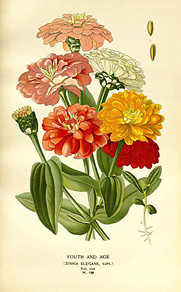Zesty Zinnias
By Audrey Stallsmith

So they filled all the pots they could find with flowers—asters and zinnias, and loose-leafed red late roses from the wall of the stable-yard, till the house was a perfect bower.
Five Children and It by E. Nesbit
My mother’s garden, which sits on a level site with heavy clay soil, suffered this year from excessive rainfall. Many of the vegetables were a “wash-out,” but her zinnias—true to their cheery nature—didn’t mind at all, and are still churning out blooms in scores of colors and sizes.
“The Zinnia can always be depended on,” A. E. Mattiers noted in an 1880 edition of Vick’s Illustrated Monthly Magazine, “no matter what the season may be. Summer before last, my zinnias were very fine, notwithstanding the drought; and they were equally good this last summer, which was an exceptionally wet season.”
Like many other fall-blooming annuals, zinnias originated in Mexico as well as the southeast United States and Central America. At that time, they didn’t look much like the flowers we know today.
The first to arrive in Europe during the 1500s, Zinnia peruviana produced only small, single yellow or orange flowers. Old botanical drawings indicate that they had much more narrow and spidery petals than modern zinnias do.
Linnaeus named the plant after German botanist Dr. Johann Gottfried Zinn, who may have grown it himself from seeds received from that country's ambassador to Mexico in 1750. Almost everybody else ignored the flower, which was even considered a weed and a mal de ojos ("eyesore") in its home country.
The D. Landreth company in Philadelphia finally offered zinnia seeds in its 1798 catalog, but I couldn't determine which type those were. They may even have been elegans, which had just reached Europe a couple years earlier. Coming in a much wider variety of hues than peruviana, it became the parent of most of our modern types.
Double zinnias didn’t appear until the mid-1800s and the jumbos originated with 'Giant Mammoth' around 1900. They took off with the discovery of Burpee’s 'Giant Dahlia' sport in the 1920s.
As Mattiers noted in 1880, the zinnia “is indebted to cultivation for its merits, being originally small, single, and insignificant. Few would recognize the zinnia of today as the Youth and Age of their grandmother’s garden, yet they are identical.” Some hold that the flower’s nickname derives from the fact that the old blooms on a plant last long enough to compete with the upstart younger ones.
Despite often being considered coarse country cousin types of flowers, zinnias have an elegance true to their species name. The artist in me is especially entranced by the intricately overlapping and frequently dark-edged “scales” which make up their calyxes.
In Mom’s garden, the plants grow as tall as 4 1/2 feet with blooms up to 5 inches across. They stand for “thoughts of absent friends” in the Language of Flowers—perhaps because we definitely miss them when they are gone!
Zinnia elegans image is from the 1896 Favorite Flowers of Garden and Greenhouse by D. G. J. M. Bois, courtesy of plantillustrations.org.








